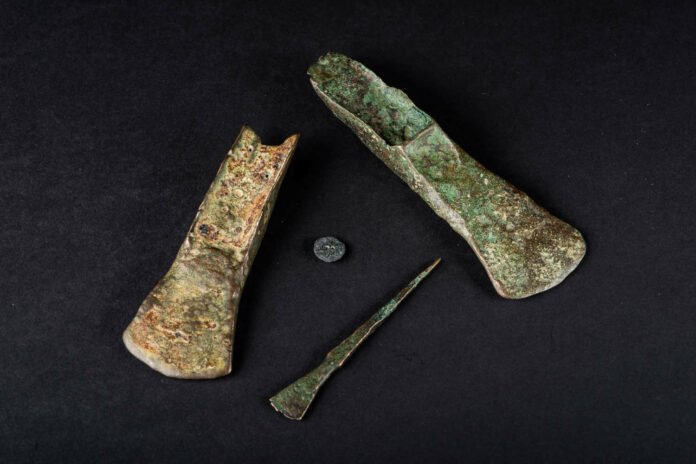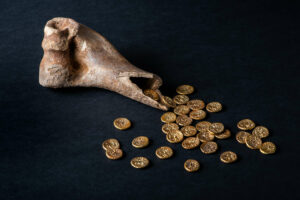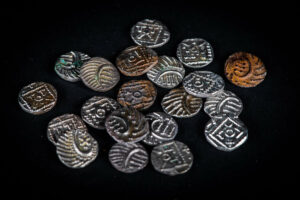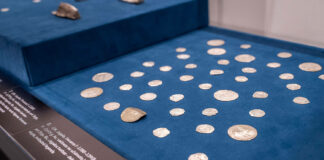
Since October 2022, a selection of stunning archaeological hoards, all discovered in West Norfolk, will be displayed at Lynn Museum. A significant number of objects will be available to view for the first time including a group of Bronze Age artefacts from the beach at Holme-next-the-Sea found close to the site of the remarkably preserved timber monument known as Seahenge. Also going on display for the first time are some very rare early coins from Fincham.
Hoards – a store of money or valued objects – have long fascinated experts and the public alike with the intriguing questions they raise: why were these objects buried; and did their owners ever mean to retrieve these precious items? West Norfolk is particularly rich in hoards, making this exhibition a perfect opportunity to discover more about the theories behind these spectacular discoveries.

One of the star exhibits is the Sedgeford Hoard, a collection of 32 gold coins, found in August 2003 at Sedgeford, Norfolk during an archaeological dig. What’s truly fascinating about these coins is that 20 were discovered inside a cow bone. The coins may have been placed inside the bone and buried as an offering to the gods. Or they may have been hidden in the cow bone, and buried, to be retrieved in the future. The exact reason behind the hoard’s burial we may never know.

The Fincham Coin Hoard dates back to the Anglo-Saxon and Viking period, around 1300 years ago. Struck about 150 miles away in Frisia, modern-day Holland, these small silver coins known as sceattas (pronounced “shatters”) are the earliest form of penny and circulated in England from around 710-750AD. The coins are in good condition, suggesting they hadn’t been in circulation long before they were hidden.
The exhibition also includes the Dersingham Hoard, a large collection of silver shillings found in a silver cup. Discovered in July 1984, this hoard was likely buried in 1643 when King’s Lynn was under siege, during the English Civil War.
Elizabeth Nockolds, Chair of the Kings Lynn and West Norfolk Area Museums Committee said “It’s very good to have such a great range of archaeological finds in our town museum for visitors to enjoy. I am also pleased that the museum team will be holding a Hoards family event at the museum during the school half term in association with this new exhibition.”
Margaret Dewsbury, Cabinet Member for Communities and Partnerships at Norfolk County Council said “I am thrilled that this collection of hoards found around West Norfolk, so close to Kings Lynn, will be on display at the Lynn Museum. It will be a fascinating exhibition that will allow the local community to view and learn about these objects, many of which have never been displayed to the public before.”
Oliver Bone, Curator of the Lynn Museum said “This has been a wonderful opportunity to bring together some spectacular groups of archaeological discoveries from our part of Norfolk, many on show for the first time. The finds offer a sweep of history from back in the Bronze Age right through to the time of the English Civil War.”
The exhibition is on show at the Lynn Museum until 11th June 2023. Further information is available on the Museum website.
Around one year ago the Portable Antiquities Scheme Database hit the mark of one million objects recorded.
Learn more about hoards in an article by Alan Walker.



